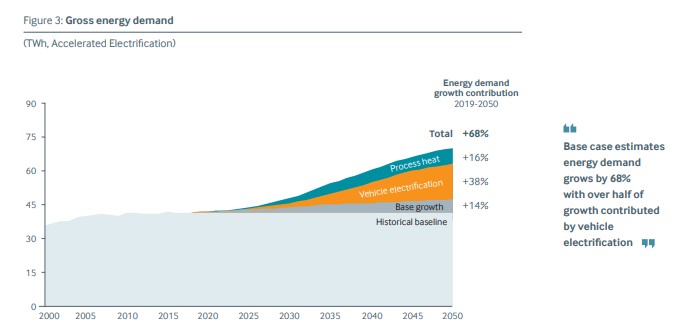Tinkerisk:
To get back to the point:
There are approximately 2,120,000 registered cars in New Zealand. Have you ever thought about how and with what energy the EV should all be charged in the future and where should it come from? (Now don't say from nuclear power plants or gas from Russia!)
I think this is quite a sidestep in a thread about the environmental impact of flaring gas in russia, but seen as it is in a off topic forum I will respond.
Yes I have thought about it at length. I am a bit of a nerd, with a personal interest in EV's (one in the driveway), and with a strong professional interest in the NZ power sector).
Our National Grid operator is giving the question a lot of thought too. Please find below TransPower documents:
From page 23 of the first report, they are modeling a 68% increase in demand:

My take:
- The uptake of EV's will be so slow, we will have time to deal it. Our fleet average age is greater than 14 years. Stack this with our current take rate being fairly low, and we have decades to deal with this. (Last month we had an exceptional number of EV deliveries, yet the amount of pure EV's was still only around the 10% mark. The epic month was due to the initial volume deliveries of Atto3, EV6 and a massive delivery month from Tesla, their deliveries are a bit lumpy depending on shipping schedules from their shanghai plant, but this included the first of the model Y deliveries.)
- NZ is fortunate to have a heap of good energy resource, so given the right motivation we could easily scale up our power production. https://en.wikipedia.org/wiki/List_of_power_stations_in_New_Zealand#Proposed_power_stations
- Light EV's aren't actually that big of a challenge to Power
- Other sectors like moving industrial process heat from fossel fuel's will be much more challenging.
In terms of the distant future possibility of electrifying 2,120,000 car's.
NZ light Vehicle km traveled is about 44 billion km/year. Typical EV energy consumption is about 17kWh/100km. Lets up that to 20kWh/100km, to allows for the lesser efficiency of stuff like van's, utes, upper large 4x4's which are currently rare / unavailable as electric.
44 billion * 0.2 = 8.8 billion kWh = 8.8 TWh / year.
For comparison in 2020, we produced 43 TWh, so under this model, we would need to build 20% more generation. (if rio tinto shut down the smelter, this would free up 5.4TWh / year, meaning we would only need to build 8% more.
The above is quite attainable from a technical point of view.
However it is not going to happen under the current NZ electricity market. It needs to be shaken up in an epic way, to incentive's the building of new renewable generation, and it would be ideal if we could do this in advance of the epic wave of additional electric load coming in a decade or two...

